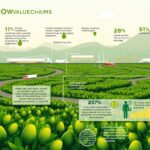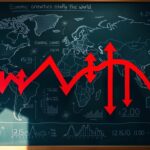The Silver Economy Surge: How Aging Populations Will Add $7 Trillion to Global GDP by 2030
The global economy is undergoing a dramatic transformation as aging populations reshape consumption patterns, labor markets, and innovation trajectories. The silver economy—an economic sector centered on the needs, challenges, and opportunities presented by older adults—is emerging as a critical driver of growth. With enhanced healthcare and longer life expectancies, this sector is projected to contribute $7 trillion to global GDP by 2030. Rising demand for senior care services, technological innovations that support independent living, and new market opportunities in leisure and lifestyle sectors are setting the stage for a silver revolution.
Changing consumer behaviors also play a decisive role. Seniors are increasingly tech-savvy and financially active while prioritizing quality of life. They seek advanced medical care and recreational products that enhance well-being. This article examines key growth sectors, the impact of an aging workforce on global productivity, and emerging investment opportunities. It also details how governments and businesses are adapting strategies—leveraging data analytics and innovation—to harness the market potential of the silver economy.
We will now transition to an in-depth exploration of the various dimensions that underpin this shift:
What Is the Silver Economy, and Why Is It Growing Rapidly?
The silver economy is the segment of the market addressing the needs and opportunities of an aging population. It includes industries such as healthcare, senior living, finance, travel, and technology. Its rapid growth is driven by longer life expectancies and declining birth rates, which create a significant demand for products tailored to the later stages of life.
How Does the Aging Population Drive Silver Economy Expansion?
As baby boomers retire, their accumulated wealth and purchasing power boost demand for senior-specific goods and services. This demographic shift spurs innovation in healthcare management, personalized medicine, and technologies that enhance daily living. In regions like North America and Europe, there is strong demand for in-home health monitors, mobility aids, and digital platforms that manage chronic diseases. At the same time, tailored financial services and specialized leisure travel packages are gaining popularity. Businesses, therefore, are reshaping their portfolios to provide products that offer safety, convenience, and comfort while stimulating growth in infrastructure development, technology integration, and workforce training.
What Are the Key Sectors Fueling Silver Economy Growth?
The foremost sectors include healthcare, technology, financial services, and senior housing. Healthcare is modernizing with telemedicine, remote monitoring, and personalized care solutions. Technological innovations such as smart-home devices and wearable trackers boost communication and safety, while financial services now offer wealth management and retirement planning products specially designed for older consumers. Senior housing and care services are evolving to include assisted living and community-based solutions supported by technology. Improvements in one sector often drive growth in others, creating a synergistic effect that multiplies overall economic output.
How Are Consumer Behaviors Changing in the Silver Economy?
Older adults are no longer passive service recipients. Today, they make informed choices based on quality, convenience, and technological ease. They seek personalized healthcare, accessible financial advice, and seamless digital shopping. Increased online research, comparison of product reviews, and demand for user-friendly platforms characterize this demographic. Additionally, cultural shifts now see seniors embracing lifelong learning, active lifestyles, and even entrepreneurship. This digital engagement is prompting companies to develop intuitive interfaces and use data analytics to meet the sophisticated expectations of senior consumers.
How Will Aging Populations Impact Global Economic Growth by 2030?
Aging populations will be a significant factor in shaping global economic trajectories. As older adults contribute more to consumer spending and drive changes in the workforce, their influence on GDP and market dynamics increases. Studies suggest that by 2030, these demographic shifts will boost global GDP by an estimated $7 trillion. This growth reflects a qualitative change in economic demand, with markets increasingly valuing durable, value-based services and sustainable growth models.
What ‘s the Projected $7 Trillion Contribution to Global GDP?
The $7 trillion projection comes from higher consumption, greater demand for health and senior services, and robust investments in innovative technologies. Governments in countries like Japan, Germany, and the United States are already increasing expenditures in response to aging demographics. Additionally, private investments in AI-assisted diagnostics and home automation are fueling performance in ways traditional sectors have not. With older adults acting as both consumers and active participants in leisure and service markets, this surge represents both an opportunity and a challenge to existing fiscal and policy frameworks.
Which Regions Will Experience the Most Significant Silver Economy Growth?
Regions with high proportions of seniors, such as Europe, North America, and parts of Asia (notably Japan and South Korea), will see dramatic growth. These areas benefit from high life expectancies and low birth rates, prompting reforms and investments in senior services. Emerging markets in Latin America and Oceania are also beginning to register gradual increases as demographic transitions take hold, underscoring the need for tailored policies that consider local healthcare infrastructure, social security systems, and cultural attitudes toward aging.
How Does the Aging Workforce Influence Productivity and Economic Output?
An aging workforce affects productivity by changing labor supply patterns and accelerating the need for automation and upskilling. While seasoned employees bring invaluable experience, shifts in work patterns and retirement timing require companies to invest in automation and digital tools. This trend often leads to the redesign of jobs and flexible work arrangements that promote innovation. In the long term, strategic investments in research and development help maintain competitiveness and improve overall productivity in an increasingly digital world.
What Investment Opportunities Are Emerging in the Silver Economy?
The expansion of the silver economy creates numerous investment opportunities across sectors. Investors are targeting companies that cater to the aging demographic through innovations in healthcare, technology upgrades, and novel senior care models. As demand for specialized products rises, sectors previously considered niche are becoming profitable, offering returns driven by both technological advancements and evolving consumer spending patterns.
Why Invest in Senior Care and Elder Services?
Senior care and elder services are growing due to increased demand for assisted living facilities, home healthcare, and innovative medical technologies. Firms offering integrated solutions—combining digital health platforms and telemedicine—are witnessing rapid revenue growth. The relative stability of healthcare needs, regardless of broader economic cycles, makes investments in this area especially attractive. Historical data shows that companies in elder care often outperform during economic downturns, making the sector a resilient option for long-term investors.
How Are Technology Innovations Shaping Silver Economy Investments?
Technological advancements such as AI, wearable diagnostics, and telehealth are transforming the way senior services are delivered. These innovations create new revenue streams and improve patient outcomes by enabling early diagnosis and efficient management of chronic illnesses. Examples include sensor-based monitoring systems that alert caregivers to potential health issues and virtual reality tools used in cognitive rehabilitation. Such innovations not only reduce operational costs but also drive high-growth investment opportunities.
What Are the Risks and Rewards of Investing in Aging Population Markets?
While the silver economy offers sustained growth and stable revenue streams, there are risks such as regulatory shifts, technological obsolescence, and market volatility. Investors must perform thorough due diligence and focus on adaptable companies. Diversification across various sub-sectors of the silver economy is a key strategy to mitigate these risks while capitalizing on the long-term rewards.
How Are Businesses and Policymakers Responding to the Silver Economy Surge?
Both businesses and policymakers are actively adapting strategies to capture the silver economy’s potential. Private companies are revamping business models to serve aging consumers better, while governments are enacting policies to support healthcare innovation, safeguard pension systems, and improve infrastructure. These coordinated initiatives are crucial to maximizing economic benefits and addressing the challenges inherent in an aging population.
What Strategies Are Companies Using to Capitalize on Aging Consumers?
Companies are prioritizing personalization, digital accessibility, and innovation to engage aging consumers. Targeted product lines—such as simplified smartphones, ergonomic home solutions, and intuitive financial planning tools—are being launched specifically for seniors. In addition, investments in market research and data analytics help companies understand shifting consumer behaviors. This customer-centric approach leads to greater brand loyalty and improved profit margins.
How Are Governments Supporting Silver Economy Growth?
Governments are providing support through policy reforms and targeted investments. Increased funding for healthcare research, streamlined approval processes for medical devices, and fiscal incentives for innovative companies are some of the measures being implemented. Many European nations, for instance, offer tax breaks and subsidies that lower healthcare reform costs. Public-private partnerships are also emerging to build smarter cities and integrated healthcare ecosystems that ensure seniors have easy access to essential services.
What Role Do Data and Analytics Play in Silver Economy Planning?
Advanced data analytics play a crucial role in understanding and planning for the silver economy. Both businesses and governments use data to monitor demographics, consumer spending, and healthcare utilization. This information helps in the efficient allocation of resources and the development of customized solutions that address the unique needs of an aging population. Predictive analytics and big data tools ensure that strategies remain responsive to market shifts.
What Challenges and Opportunities Does the Silver Economy Present?
The shift toward an older population brings both challenges and opportunities. While new market niches are emerging, significant strains are being placed on healthcare systems, pension schemes, and labor markets. Successfully navigating these dual aspects is essential for long-term economic sustainability.
How Can Industries Overcome Workforce Aging Challenges?
Industries can mitigate the impact of an aging workforce by employing retraining programs, flexible working arrangements, and technological automation. Digital platforms that promote remote work and mentorship programs that capitalize on older employees’ experience are key strategies. The integration of robotics and AI helps reduce physical strain and supports cognitive tasks, ensuring that productivity remains high despite workforce aging.
What Social and Economic Benefits Arise From an Aging Population?
An aging population can enhance consumer spending stability and savings rates, leading to a more secure market environment. With predictable spending patterns and accumulated wealth, older consumers drive steady demand for goods and services. Social benefits include stronger community engagement, improved public health outcomes, and reduced isolation, which in turn can lower overall healthcare costs and improve quality of life.
How Will Silver Economy Growth Affect Global Markets and Trade?
The expansion of the silver economy will reshape global trade, with increased exports of medical devices, assistive technologies, and specialized care services. As companies adapt their sourcing and manufacturing processes to meet the needs of aging consumers, global supply chains and bilateral trade agreements will be influenced. This evolution is expected to foster international collaboration and innovation as nations work together on common standards.
How Can Businesses Prepare for the Silver Economy Surge?
To capitalize on the silver economy, businesses must adopt agile and proactive strategies. Refining product designs, enhancing digital accessibility, and investing in customer-centric innovations are essential steps. Companies that successfully prepare for this shift not only gain a competitive revenue edge—they also position themselves as leaders in market transformation.
What Are the Best Practices for Engaging Senior Consumers?
Effective engagement requires clear communication, personalization, and an emphasis on quality. Companies are adopting robust digital interfaces and offering services like in-person demonstrations and digital literacy classes to build trust. Multi-channel communication strategies ensure that information reaches seniors regardless of their technological proficiency, thereby boosting brand loyalty and customer satisfaction.
How Can Companies Innovate to Meet Silver Economy Needs?
Innovation is critical in designing products and services that enhance the quality of life. Companies are exploring virtual reality applications for healthcare diagnostics and digital companion systems that combine functionality with emotional support. In financial services, simplified banking interfaces and retirement planning tools are being developed specifically for the aging demographic. Collaborations with healthcare institutions and technology startups are essential to creating ecosystems that meet the varied needs of seniors.
What Tools and Resources Help Track Silver Economy Trends?
Advanced analytics platforms, market research reports, and real-time monitoring tools are being employed to track trends in the silver economy. Digital dashboards that integrate data from demographic studies and economic indicators provide valuable insights. These tools support strategic planning and investment decisions by forecasting market shifts and consumer demand.
What Future Trends Will Shape the Silver Economy Beyond 2030?
Beyond 2030, global technological advancements, evolving cultural norms, and continued demographic shifts will further transform the silver economy. Digital innovation combined with personalized care is likely to drive the next phase of expansion, as organizations and governments invest in research, infrastructure, and policy reforms geared toward sustainable, long-term development.
How Will Demographic Shifts Continue to Influence Economic Growth?
Continued declines in fertility rates alongside increasing life expectancy will result in a significant rise in the proportion of older adults globally. This shift will drive new consumer behaviors and stimulate investments in healthcare, leisure, and technology. As seniors increasingly contribute to innovation and market trends, businesses and policymakers will need to recalibrate strategies to ensure that economic systems remain resilient and inclusive.
What Emerging Technologies Will Transform Elder Services?
Technologies such as artificial intelligence, robotics, and the Internet of Medical Things are set to revolutionize elder services. Innovations like AI-driven diagnostics, predictive healthcare analytics, and real-time monitoring systems will offer more personalized and efficient care. Robotics can provide physical assistance and reduce social isolation, while wearable devices and smart home technologies continuously monitor health indicators, ensuring timely intervention and reducing costs.
How Will Global Collaboration Enhance Silver Economy Development?
International collaboration will be key to overcoming the challenges posed by an aging global population. By sharing best practices and harmonizing standards, partnerships among governments, private enterprises, and academic institutions will drive joint investments in research and innovation. Multinational trade agreements focused on elderly care and healthcare infrastructure will further boost economic integration and sustainable growth worldwide.
Frequently Asked Questions
Q: What exactly does the silver economy encompass?
A: It refers to the market segment focused on products, services, and infrastructure tailored to an aging population, including sectors such as healthcare, technology, finance, and housing.
Q: How is the estimated $7 trillion impact on global GDP calculated?
A: The figure is based on projected increases in consumer spending by seniors, investments in healthcare and technology innovations, and improved productivity from supportive policy measures.
Q: Which regions are expected to benefit most from silver economy growth?
A: Forecasts indicate that Europe, North America, and parts of Asia—especially Japan and South Korea—will experience the fastest growth, while emerging markets in Latin America and Oceania will see gradual gains.
Q: What are the main risks associated with investing in the silver economy?
A: Key risks include regulatory changes, potential technological obsolescence, and market volatility; however, stable revenue streams often offset these risks when companies are well-managed.
Q: How can companies effectively adapt their strategies to serve aging consumers?
A: Companies are focusing on personalization, investing in digital accessibility, and using data analytics to understand evolving consumer behavior, thereby enhancing product quality and customer satisfaction.
Q: How will emerging technologies transform services for older adults?
A: Technologies like AI, robotics, and smart home devices will enable personalized healthcare, improve monitoring systems, and provide user-friendly tools that support independent living while reducing costs.
Q: What role does global cooperation play in enhancing the silver economy?
A: Global cooperation supports information sharing, harmonizes regulatory standards, and promotes joint investments in research and development to fully leverage the silver economy’s potential.
Final Thoughts
The silver economy surge is reshaping global markets as aging populations drive shifts in consumption, innovation, and workforce strategies. By adopting agile, data-driven approaches, businesses and policymakers can harness opportunities and overcome challenges. Strategic global collaboration and technological advancements will not only drive sustainable growth but also enhance the quality of life for seniors. Preparing for this transformation today lays the foundation for a resilient and inclusive economic future.









































































































